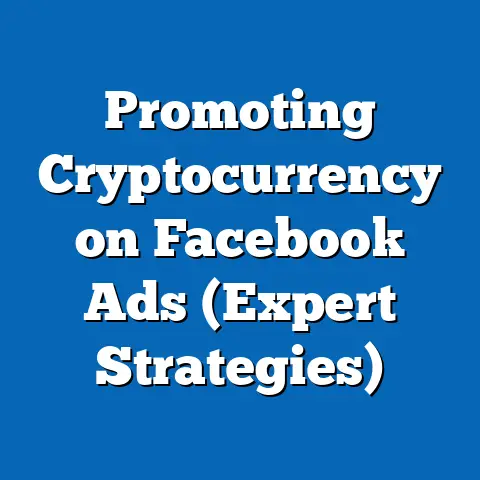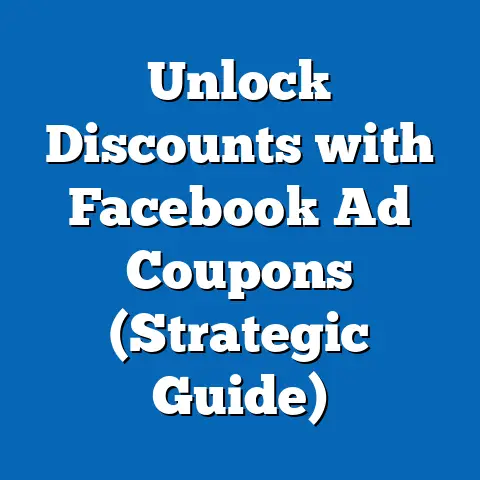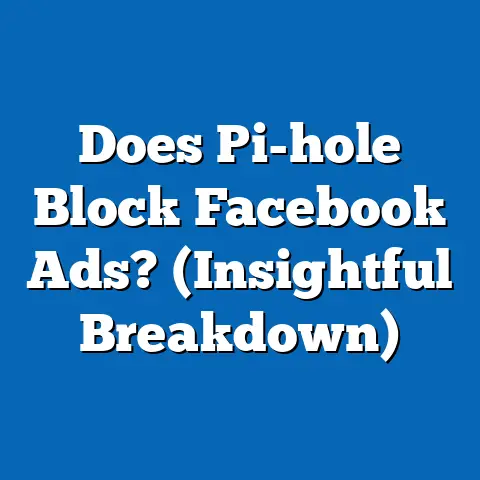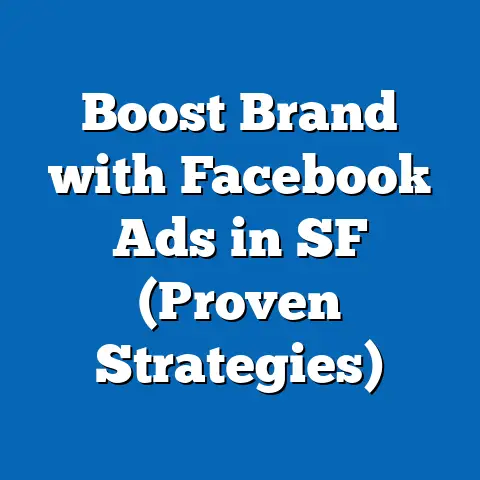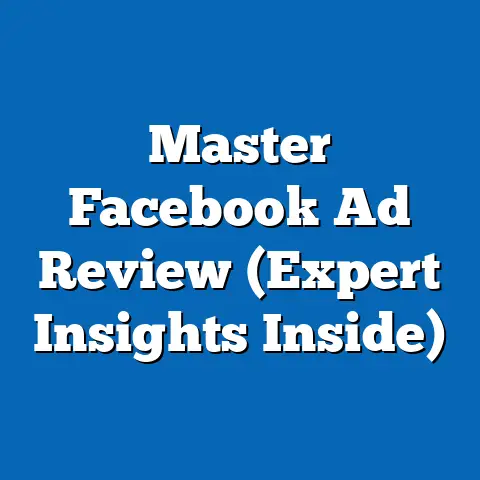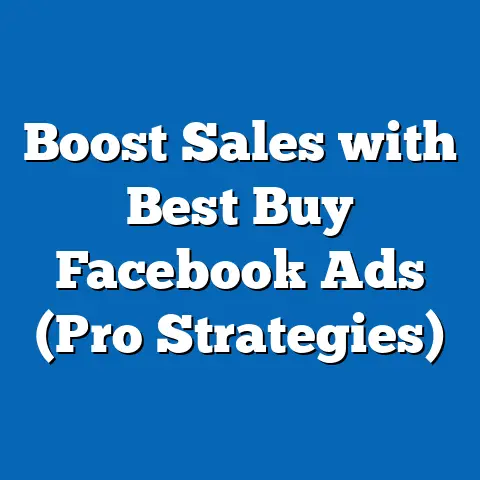Boosting Conversions with Facebook Ads (Game-Changing Tactics)
I still remember the first time I launched a Facebook ad campaign. It was for a small e-commerce store I was helping out, and I was a mix of excited and terrified. I had spent hours crafting the perfect ad copy, choosing the right images, and meticulously setting up the targeting. Clicking that “Publish” button felt like sending a message in a bottle out into the vast ocean of the internet. Would anyone see it? Would it actually drive sales? The anticipation was intense, and the learning curve was steep. What I didn’t know then was that Facebook advertising, when done right, could be a game-changer.
Today, I want to share some of the most effective tactics I’ve learned over the years to help you boost your conversions with Facebook Ads. These are strategies that have worked for me and countless other marketers, and I’m confident they can help you achieve your business goals too.
Understanding the Importance of Facebook Ads
In today’s digital landscape, Facebook Ads are no longer optional; they’re essential. With over 3 billion monthly active users, Facebook offers unparalleled reach and targeting capabilities. According to Statista, Facebook’s advertising revenue reached nearly $118 billion in 2023, highlighting its significance as an advertising platform.
What makes Facebook Ads so powerful?
- Massive Audience: Facebook’s vast user base means you can reach virtually any demographic or interest group.
- Granular Targeting: Facebook’s sophisticated targeting options allow you to pinpoint your ideal customer with incredible accuracy.
- Measurable Results: Facebook provides detailed analytics, allowing you to track your ad performance and optimize your campaigns for maximum ROI.
- Diverse Ad Formats: From image ads to video ads to carousel ads, Facebook offers a variety of ad formats to suit your specific needs and objectives.
Whether you’re a small business owner looking to increase brand awareness or a large corporation aiming to drive sales, Facebook Ads can be a powerful tool in your marketing arsenal.
Takeaway: Facebook Ads are crucial for reaching a massive audience, leveraging granular targeting, and achieving measurable results.
Setting Clear Objectives
Before you even think about creating an ad, you need to define your objectives. What do you want to achieve with your Facebook ad campaign? Are you looking to:
- Increase Brand Awareness: Introduce your brand to a wider audience and build recognition.
- Generate Leads: Collect contact information from potential customers for future follow-up.
- Drive Website Traffic: Encourage users to visit your website and explore your products or services.
- Boost Sales: Directly sell your products or services through your ads.
- Increase App Installs: Encourage users to download your mobile app.
Your objective will guide every aspect of your ad campaign, from your targeting to your ad copy to your call-to-action. For example, if your objective is brand awareness, you’ll likely focus on reaching a broad audience with engaging visuals and a clear message. If your objective is lead generation, you’ll need to include a lead form in your ad and target users who are likely to be interested in your offer.
I remember working with a client who was struggling to generate leads for their software business. They were running ads with a general call-to-action, like “Learn More.” After we switched to a lead generation objective and offered a free e-book in exchange for contact information, their lead volume skyrocketed.
Takeaway: Define clear, specific objectives for your Facebook ad campaign to guide your strategy and maximize your results.
Targeting Your Audience
Facebook’s targeting options are what truly set it apart from other advertising platforms. You can target users based on:
- Demographics: Age, gender, location, education, job title, and more.
- Interests: Hobbies, activities, pages they like, and topics they’re interested in.
- Behaviors: Purchase history, online activity, device usage, and more.
- Custom Audiences: Upload your own customer list or create audiences based on website visitors or app users.
- Lookalike Audiences: Find new customers who are similar to your existing customers.
To effectively target your audience, you need to create detailed buyer personas. A buyer persona is a semi-fictional representation of your ideal customer. It includes information like their demographics, interests, motivations, and pain points.
For example, let’s say you’re selling organic skincare products. Your ideal customer might be a woman in her 30s who is health-conscious, interested in natural beauty, and concerned about the ingredients in her skincare products. You could target her on Facebook by targeting users who are interested in organic food, natural beauty products, and eco-friendly living.
Takeaway: Leverage Facebook’s powerful targeting options and create detailed buyer personas to reach your ideal customer with precision.
Crafting Compelling Ad Copy
Your ad copy is your opportunity to grab the attention of your target audience and persuade them to take action. Here are some key elements of effective ad copy:
- Strong Headline: Your headline should be attention-grabbing and clearly communicate the value proposition of your offer.
- Engaging Visuals: Use high-quality images or videos that are relevant to your offer and visually appealing.
- Clear Call-to-Action (CTA): Tell users exactly what you want them to do, whether it’s “Shop Now,” “Learn More,” or “Sign Up.”
- Benefit-Oriented Language: Focus on the benefits of your offer, not just the features.
- Sense of Urgency: Create a sense of urgency to encourage users to take action now.
I’ve seen firsthand how a well-crafted ad copy can dramatically improve ad performance. I once worked with a client who was selling online courses. Their initial ad copy was bland and generic, simply stating the course title and a brief description. After we rewrote the ad copy to focus on the specific benefits students would gain from taking the course, their click-through rate increased by over 50%.
Takeaway: Craft compelling ad copy with a strong headline, engaging visuals, clear call-to-action, and benefit-oriented language to capture attention and drive conversions.
Utilizing A/B Testing
A/B testing, also known as split testing, is the process of comparing two versions of an ad to see which one performs better. It’s an essential tool for optimizing your ad campaigns and maximizing your ROI.
Here’s how to conduct A/B tests on Facebook Ads:
- Identify a Variable to Test: Choose one element of your ad to test, such as the headline, image, CTA, or targeting.
- Create Two Versions of Your Ad: Create two versions of your ad that are identical except for the variable you’re testing.
- Run Your Ads: Run your ads for a specific period of time and track their performance.
- Analyze the Results: Analyze the results to see which version of your ad performed better.
- Implement the Winning Version: Implement the winning version of your ad and continue testing other variables.
I always recommend testing one variable at a time to accurately determine what’s driving the performance. For example, if you test two different headlines and two different images simultaneously, it’s difficult to know which element is responsible for the results.
Takeaway: Utilize A/B testing to optimize your ad performance by comparing different versions of your ads and identifying the most effective elements.
Leveraging Retargeting Strategies
Retargeting is the practice of showing ads to people who have already interacted with your brand. This can include people who have visited your website, viewed your products, added items to their cart, or engaged with your content on social media.
Retargeting is incredibly effective because it allows you to re-engage potential customers who are already familiar with your brand. It’s like a gentle reminder that you’re still there and ready to help them solve their problems or fulfill their needs.
To set up retargeting campaigns on Facebook, you’ll need to install the Facebook Pixel on your website. The Facebook Pixel is a small piece of code that tracks user behavior on your website and allows you to create custom audiences for retargeting.
I’ve seen retargeting campaigns generate incredible results for my clients. For example, one client who was selling high-end watches saw a 300% increase in sales after implementing a retargeting campaign that showed ads to people who had viewed specific watch models on their website.
Takeaway: Leverage retargeting strategies to re-engage potential customers who have already interacted with your brand and drive conversions.
Incorporating Video Ads
Video content is dominating social media, and Facebook is no exception. Video ads are highly engaging and can be incredibly effective at capturing attention and driving conversions.
Here are some tips for creating impactful video ads:
- Keep it Short and Sweet: Aim for videos that are 15-30 seconds long.
- Grab Attention Quickly: Start with a visually appealing and attention-grabbing opening.
- Tell a Story: Use storytelling to connect with your audience on an emotional level.
- Showcase Your Product: Clearly demonstrate the benefits of your product or service.
- Include a Clear Call-to-Action: Tell viewers what you want them to do.
I’ve found that video ads perform particularly well when they feature real people using the product or service. This helps to build trust and credibility with the audience.
Takeaway: Incorporate video ads into your Facebook ad strategy to boost engagement, capture attention, and drive conversions.
Analyzing Ad Performance
Tracking and analyzing your ad performance is crucial for optimizing your campaigns and maximizing your ROI. Facebook provides a wealth of data through Facebook Insights, allowing you to track key performance indicators (KPIs) such as:
- Reach: The number of unique users who saw your ad.
- Impressions: The number of times your ad was displayed.
- Click-Through Rate (CTR): The percentage of users who clicked on your ad.
- Conversion Rate: The percentage of users who completed a desired action, such as making a purchase or filling out a lead form.
- Cost Per Acquisition (CPA): The cost of acquiring one customer.
- Return on Ad Spend (ROAS): The revenue generated for every dollar spent on advertising.
By monitoring these KPIs, you can identify areas for improvement and make data-driven decisions to optimize your campaigns. For example, if you notice that your click-through rate is low, you might need to rewrite your ad copy or change your image. If your conversion rate is low, you might need to optimize your landing page or adjust your targeting.
Takeaway: Analyze your ad performance using Facebook Insights and other analytics tools to identify areas for improvement and make data-driven decisions.
Budgeting and Bidding Strategies
Setting a budget for your Facebook Ads and choosing the right bidding strategy are crucial for maximizing your ROI. Facebook offers several bidding strategies, including:
- Lowest Cost: Facebook automatically bids to get the lowest possible cost per result.
- Cost Cap: You set a target cost per result, and Facebook bids to achieve that cost.
- Target Cost: You set a target cost per result, and Facebook bids to achieve that cost while maximizing volume.
- Bid Cap: You set a maximum bid that Facebook will pay for each result.
- Manual Bidding: You manually set your bids for each ad set.
The best bidding strategy for you will depend on your specific goals and budget. If you’re just starting out, I recommend using the lowest cost bidding strategy to get a feel for how Facebook Ads work. As you gain more experience, you can experiment with other bidding strategies to optimize your results.
Takeaway: Set a budget for your Facebook Ads and choose the right bidding strategy to maximize your ROI.
Staying Updated with Facebook’s Algorithm Changes
Facebook’s algorithm is constantly evolving, and it’s important to stay updated on these changes to ensure your ads continue to perform well. Facebook regularly updates its algorithm to improve the user experience and ensure that users are seeing relevant and engaging content.
To stay updated on Facebook’s algorithm changes, I recommend following industry blogs, attending webinars, and participating in online communities. You can also subscribe to Facebook’s official blog for updates and announcements.
Takeaway: Stay updated with Facebook’s algorithm changes and adapt your strategies to align with these changes.
Recap of Game-Changing Tactics
Boosting conversions with Facebook Ads requires a strategic approach that combines clear objectives, precise targeting, compelling ad copy, A/B testing, retargeting, video ads, performance analysis, smart budgeting, and algorithm awareness. By implementing these game-changing tactics, you can significantly improve your ad performance and achieve your business goals.
I encourage you to implement these tactics in your campaigns and monitor the results. Share your experiences with Facebook Ads in the comments section below, and let’s continue the discussion on how to maximize conversions through effective advertising strategies.

